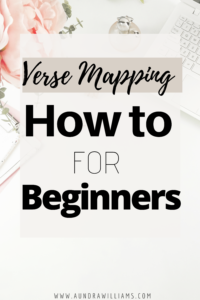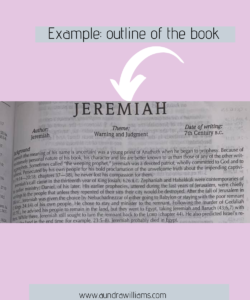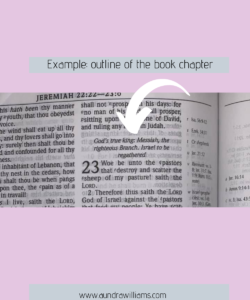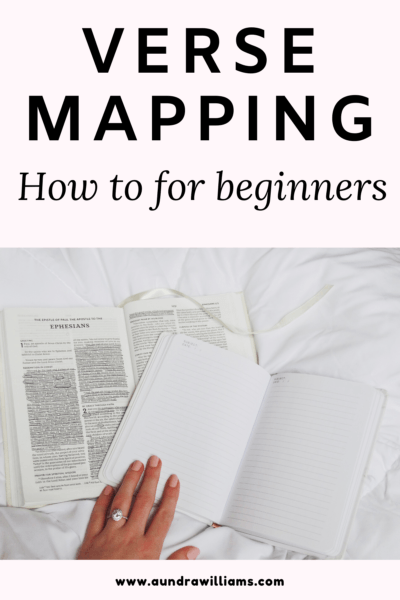Are you looking to dive deeper into God’s word with verse mapping?
I remember, for the longest time, I craved to have a more profound encounter with God during my bible study, alone time with God, but I was unsure where to begin.
It wasn’t until ministry training that I was first introduced to what verse mapping entailed. Once I implemented the steps, it was as if God’s presence became alive, and I and felt God as if he was before me in the physical posture.
It was such a beautiful moment, and I thought many of you are like myself, desiring to see God more, to understand his word better.
So, how does one include verse mapping as a beginner into their study time?
Simple, come along with me as I show you verse mapping how to for the beginner?
But, first, what is verse mapping?
Verse Mapping is a method of studying the Bible in a way that unpacks the scriptures using word origins, historical context, definitions, maps, and prayer to help you find deeper meaning in God’s Word and apply it to your life.
Pin for later

Now that we know what verse mapping lets dive into how you can apply it for your next Bible study, alone time with God.
#1. Where do you begin?
- Choose a book of the Bible. The Bible has several genres or categories of literature. Some of the genres include:
a. Didactic – teachings such as the epistles (Pauline writings, Peter’s books, James, etc.)
b. Narratives – stories in the Old Testament and Gospels
c. Poetic – Psalms, Proverbs, Ecclesiastes, Song of Solomon, Job.
d. Prophetical Books – the foretelling of future events. These books include the book of Revelation, Zechariah, etc.
Choose the Tools to Use ( to optimize your study)
a. Apps: BLB: Blue Letter Bible App is useful for word study.
You version app – suitable for word search and listening to the Bible. Which is my favorite.
b. Commentaries – Theological (My favorite is David Guzik); Application (Warren Wiersbe).
c. Read through several versions of the Bible; NASB, ESV, NIV, NKJV, NLT, NET ( Each Bible uses different verbiage)
d. Colored pencil, highlighters to mark the Bible.
e. Journal to write notes, or whatever comes to your mind.
f. Create a Chart at a glance sheet
Now, after you gathered all that need choose how you would like to dissect the scriptures you have 2 options which are:
a. Inductive – attempts to come to general conclusions after examining particular bits of information found in the text. The details of the book are discovered, then interpretation, principles, and applications are formed.
b. Deductive -starts with general truths and then attempts to find particulars that lead up to the general fact.
Inductive Bible studying is the easiest way to study if you were to ask me, so for the sake of the verse mapping lets say you’re doing inductive style Bible studying.
Inductive will entail the following steps:
a. Observation – Answers the question: What does the text say?
b. Interpretation – Answers the questions: What does the text mean? What is the timeless truth in the passage?
c. Transformation – Answers the question: How does God want to change my thinking, attitude, affections, perspective, and behavior?
d. Application – How does this apply to my life today?
e. Preparation – How do I prepare the lesson in a way that is clear and concise?
f. Communication – Answers the question: How can I communicate God’s truth in a relevant, understandable way to be used by God to transform the hearts and lives of other people?
Pin for later

#2. Pray
To best observe, we must start with prayer. When we pray, God opens our minds and hearts to His Truth, and He opens us up to see it more clearly. When we pray, we collaborate with God, but if we go about reading and studying on our own, we are left to our limited human capacities.
Here are some verses to pray:
- Ask God to open your eyes to see wondrous things in His Word. Psalm 119:18 (ESV) Open my eyes that I may behold wondrous things out of your law.
- Ask the Lord to search your heart to see if there is any unconfessed sin. Psalm 139:23-24 (ESV) Search me, O God, and know my heart! Try me and know my thoughts! (24) And see if there be any grievous way in me, and lead me in the way everlasting.
- Repent of any sin God reveals to you. Job 34:32 (ESV) teach me what I do not see; if I have done iniquity, I will do it no more.
- Ask God to cleanse you from your sin. Psalm 51:7 (ESV) Purge me with hyssop, and I shall be clean; wash me, and I shall be whiter than snow.
- Ask God to give you a new heart and right spirit. Psalm 51:10 (ESV) Create in me a clean heart, O God, and renew a right spirit within me.
- Ask God to transform you by renewing your mind through this study: Romans 12:2 (ESV) Do not be conformed to this world, but be transformed by the renewal of your account, that by testing you may discern what the will of God is, what is right and acceptable and perfect.
- Ask God to give you an understanding of His Word so you may obey it with your whole heart: Psalm 119:34 (ESV) Give me understanding, that I may keep your law and observe it with my whole heart.
- Ask God to teach you the Bible by the power of the Holy Spirit: Psalm 25:4-5 (ESV) Show me your ways, Lord, teach me your paths. (5) Guide me in your truth and teach me, for you are God my Savior, and my hope is in you all day long.
I would encourage you to pray through the above verses right before you begin your study time. Praying and seeking the Lord will open your heart and mind for the Lord to teach you, direct you, and transform you.
#3. Create a chart for each chapter
The Chart should include sections for each chapter and area where you can write the author, recipients, date, purpose, and keywords you discover in the chapters.
Are you unsure where all of this information is located?
Check out the beginning of each book in the Bible, it will give you a short bio about what each book will be about. This Chart will help when you create your Chart at a Glance.


#4. Color Coding the Bible
My favorite part!!!
Yay! Color coding the Bible 🙂
Author/Recipients Red & Blue
1. Who is writing this letter? Color that person and any pronoun with red in all the chapters.
2. To whom is he/she speaking? Color the recipient(s) and any pronouns that refer to them with red in all the chapters.
3. On a separate sheet of paper, write down all that is written about the author and on a separate sheet of paper. Write down all that is written about the recipients answering the questions: who, what, where, why, when?
God/Son/Holy Spirit (yellow)
1. Mark the words that refer to God, Jesus, and Holy Spirit (mark all the pronouns that apply to them as well. Mark God with a triangle, Jesus with a cross, and the Holy Spirit with a cloud. Use the color yellow.
2. The next step is using the 5W’s to write down all you see about God on a separate sheet of paper. Do the same for Jesus and the Holy Spirit. Once again, make sure you separate them by chapter and verse.
Key Words/Phrases /Themes (purple)
- Look for keywords or repeated words and phrases. Mark them and the pronouns that refer to them with purple.
2. On a separate sheet of paper, write down any observations about these repeated words using the 5W questions.
Key verbs (green)
Unless you have studied the original languages, it will be hard to tell the forms of verbs and the intended purpose of the forms. My recommendation for verbs is using the Hebrew – Greek Key Word Study Bible in the NASB.
Instructions/Warnings (orange)
Read the text one more time. See if there are any instructions, commands, or warnings that stand out. The way to differentiate between those words is to use stars, squiggly lines, double lines on top of the word, etc. Mark those in orange and on a separate sheet of paper, using the 5W questions write down any insight you gain on this passage.
Extra Words to Consider (brown)
Look for the following words
- So that and answer this question: what information did the author give? And what is the purpose is he coming to?
- Therefore – which means for…again, ask the question: what information did he give previously, and what purpose is he concluding with?
- These things: when you come up with this phase, ask yourself, what matters?
- But – the author contrasts, so find out what topics he is contrasting.
- For This Reason –

#5. Interpretation
Outline: Divide the chapter into topics use the chart in a glance for this part.
You have learned so much now about the author, recipients, God, and the keywords mentioned in the text. After you have done all that work. Look at the text again and discern the sections in the passage and how they are structured. The way to look for a part is to follow these steps as you read the passage
- As as you read, answer this question: What is the author talking about here? What is the subject?
- When does he change the topic to another, and how does he do that?
- Look for words like But, So That, Therefore
- Which passages talk about that particular topic?
As you do that, you are discovering the structure of the passage. For each topic, write the big idea of that section. In other words, give it a title. Put these divisions and titles on your “Chart at a Glance
Dictionaries
This is an excellent time to look up the meaning of and definition of words by looking them up in a dictionary.
When you use the BLB app, it will also tell you where the word is used within the book and outside the book. It will also tell you how it was translated in different passages.
this is key for you to note on a separate paper you will title, “keywords.” Once you have the keywords, write them in your Chart titled, “Chart at a Glance.
Commentaries:
This is also an excellent time to use commentaries for any passages that are hard to understand, words that are unclear or phrases that don’t make sense to you. Make sure you do not go to them first, but only after you have done your observations.
As you interpret the passage, you need to write down the timeless principle: the truth that applied then, now, and what will use in the future.
Also, you need to make sure you are considering the “whole counsel of God” as you are asking these questions.
Write down your answers.
Transformation
Transformation answers the question: How does God want to change my thinking, attitude, affections, perspective, behavior?
Without a changed heart and mind, our actions will never change. We can control our practices temporarily when we know it is right or wrong for us to act a certain way.
But when our thought processes and perspective change, we will see a tremendous and lasting behavioral change. Of course, it is God who changes our affections and attitudes.
There are many times when I get on my knees and say, “Lord, I know this wrong, but I confess that I love and enjoy doing it.
Please change my affections to hate that which You hate and love that which You love for me.”
Other times, we discover a pattern of thinking in our lives, and so when we recognize that, we give it to God to change us.
In this particular passage you are studying, how does God want to change your thinking, attitude, or perspective?
Application
Once we discover how the Lord wants to change our thinking, then we can ask God how He wants us to apply this truth in our lives to change our behavior.
Here is an acronym that will help you discover the transformation and application of the passage
APPLICATIONS
A = Is there an attitude I need to adjust?
P = Is there a promise I need to claim?
P = Is there I priority I need to change?
L = Is there a lesson I need to learn?
I = Is there an issue I need to resolve?
C = Is there a command I need to obey?
A = Is there an activity I need to avoid?
T = Is there a truth I need to believe?
I = Is there an idol I need to tear down?
O = Is there an offense I need to forgive?
N= Is there a new direction I need to take?
S= Is there a sin I need to confess?
Once you know how the Lord wants you to apply this truth, write it down. Now you are ready to share with others the truth God has given you.
Lastly, now you can apply the stamp method to your Bible Study. Here is the stamp method Printables.
Also if you need a visual look of things check out this video
Hopefully this helps and now you’re a master a verse mapping! Let me know if this helps you.
Thank you to Rockie Naser ( www.hopeintersectingsoul.com) for the tips!


leave a comment